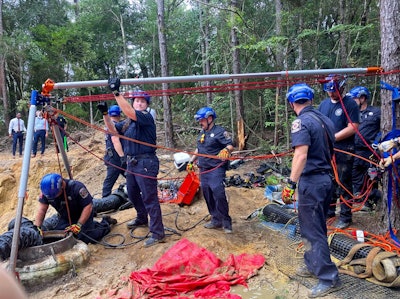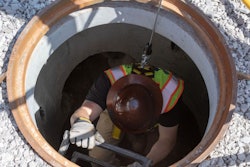
Two workers died and another was injured on a sewer installation project August 11 in Mobile, Alabama, possibly due to gas exposure.
According to Mobile Fire-Rescue, a worker entered a manhole and did not return. A second worker followed and also did not return. A third went down and was able to climb out, though he had become disoriented. The hole was reportedly 20 feet deep, according to Fox10 TV news station.
Emergency responders were able to remove the two workers from the manhole. All three were taken to a nearby hospital, but the first two workers were pronounced dead, according to Fire-Rescue.
Mobile police identified the first worker in the manhole as Garrett Mitchell Robertson. The 31-year-old from Agricola, Mississippi, is survived by his wife and five children, according to his obituary. "More than anything he loved his babies, all 5. When Garrett wasn't working, he was spending time with his kids."
The second worker in the manhole who died was Herber Rivas, 50.
The cause of the incident is under investigation.
Construction Labor Services Inc. of Eight Mile, Alabama, is the contractor on the project and the workers’ employer. The company was awarded a $2.3 million contract by the Mobile Area Water & Sewer System to install an 18-inch sewer line, according to Monica Allen, MAWSS public relations manager. "At the time of the accident the contractors were plugging a sewer line to bypass a section so they could replace the sewer pipe," Allen said. The work was part of an ongoing contract that began in December.
Fire-Rescue officials suspect the men were were exposed to gas, which would explain the disorientation, according to Fox 10’s report. Equipment World reached out to Construction Labor Services for comment but has not received a response.
The U.S. Occupational Safety and Health Administration has set standards for the construction industry regarding hydrogen sulfide, also known as sewer gas. It can occur naturally in manholes. Exposure can result in mild symptoms, like headaches or eye irritation, to unconsciousness and death, even at low concentrations. It is also highly flammable.
OSHA calls for the following steps to evaluate and control worker exposure to hydrogen sulfide:
- Evaluate exposure to know whether hydrogen-sulfide gas is present and at what levels.
- Eliminate the source of hydrogen sulfide whenever possible.
- If the source cannot be eliminated, control exposures by using engineering controls as the next best line of defense or developing administrative controls and safe work practices to reduce exposures to safe levels. These include exhaust and ventilation systems, training and educating workers about hazards and controls, and establishing proper rescue procedures to safely rescue someone from a hydrogen-sulfide exposure.
- Use respiratory and other personal protective equipment if engineering controls and work practices alone cannot reduce hydrogen sulfide to safe levels.










